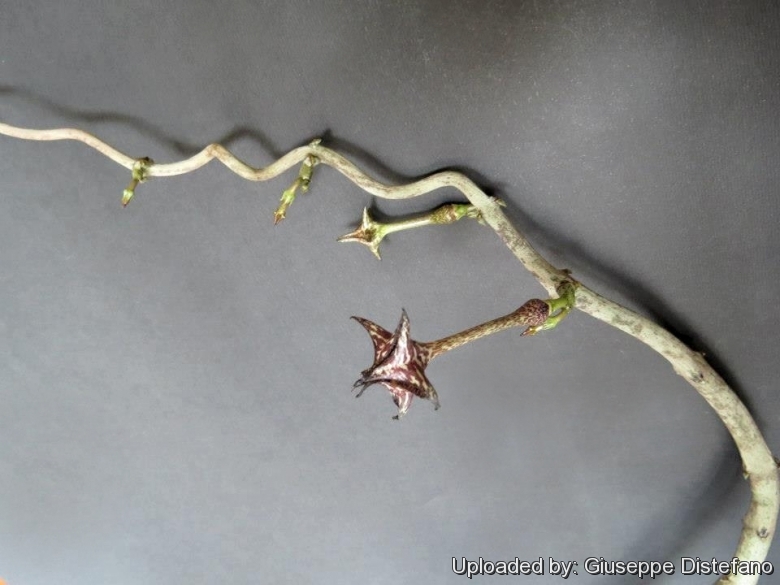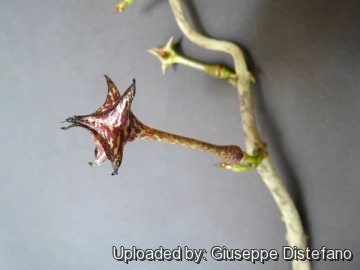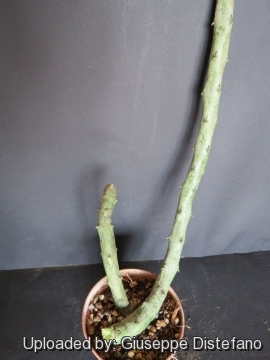




Your support is critical to our success.

Origin and Habitat: Ceropegia cimiciodoraSN|29271]]SN|29271]] is found, only rarely, north of the Soutpansberg in the Transvaal (South Africa), with no further record to Swaziland and Zululand.
Habitat and ecology: It occurs under hot conditions in the shelter of scrub bush.
Synonyms:
- Ceropegia cimiciodora Oberm.
Description: Ceropegia cimiciodora is a succulent climber with rudimentary leaves closely allied to Ceropegia stapeliaeformis, with its similar thick, mottled leafless twining stems. Although of unattractive habit, the flowers are rather striking, the corolla being mottled grey and speckled with purple-maroon. The top of the bloom is an open star-shape and the petals are ciliate on the edges.
Derivation of specific name: The name “cimiciodora” refers to the unpleasant odour of a bed-bug emitted by its flowers. As a general rule, Ceropegia flowers have no unpleasant scent, but, Ceropegia cimiciodora has a very disagreeable smell.
Habit: It is a low growing succulent species creeping, scrambling or twining. It has either climbing stems, thin and more than one metre long, especially in the case of plants grown in a warm and moist atmosphere (green-houses), or short, gnarled stems, about 20 cm long, creeping on the surface or burrowing into the ground.
Stem: Stems fleshy, twining and climbing, sparsely branched, 1-1,8 cm thick near the base, tapering toward the tip, several to many metres in length, full of a clear milky juice, rounded, glabrous, tuberculate, shiny, greyish, mottled with olive-green, glabrous. The creeping stems can take root, leaving older parts behind to wither and die.
Leaves: Rudimentary and ephemeral at the growing tips only, represented by minute triangular to cordate scales with robust milky-cloudy stipular glands.
Root: Rootstock producing fibrous roots.
Leaves: Sessile, rudimentary and ephemeral at the growing tips only, represented by minute triangular or subcordate scales ca. 2,5 x 3 mm.
Flowers: 1-2 together, opening in succession on short peduncle. The flower is most curious looking with the corolla, instead of being flat, as in Stapelias, is expanded at the mouth, and is much larger in proportion to the essential organs inside it and with lobes free with the top star-shaped. Pedicels ca. 8 mm long. Sepals ovate-lanceolate, 2 mm long. Corolla about 50 mm long, curved, glabrous, mottled grey and speckled with purple at apex; tube with small white ring at base within, inflated at base and gradually narrowed to about the middle, then expanded to funnel-shaped mouth, pilose within base and at mouth; lobes free, opening star-like from above, ciliate, each appearing like a donkey's ear, overall about 20 mm diam. Corona: outer series cup-shaped, forming 5 deep pockets with outer margin 2-toothed and sometimes with a smaller one between, with long, white hairs within and on margin; inner lobes arising from within base of outer tube, incumbent-erect-spreading, with 2 brown stripes from base.
Blooming season: Spring to early summer. The fragile blooms last for several days on the plant. It blooms when the vine reaches about 60 cm in length.
Fruits: Typical twin seed horns (follicles), grey-green, erect, broadly fusiform, spreading-curved, thinly tuberculate about 10 cm long with tubercles. Stigmas becoming knob-like.
Similar species: It is closely allied to Ceropegia stapeliaeformis and similar in habit, shape of corolla-tube and, to some extent, in the corona, but the opening of the corolla-lobes is markedly different: in C. stapeliiformis the tips of the lobes become free and spread apart, very rarely becoming twisted, while in C. cimiciodora the tips of the lobes are free with the top star-shaped looking.
Bibliography: Major references and further lectures
1) Dr J.P. Roux “Flora of South Africa” 2003
2) Inez C. Verdoorn, L. E. W. Codd “Wild Flowers of the Transvaal” Trustees, Wild Flowers of The Transvaal Book Fund, 1962
3) “Gardeners Chronicle & New Horticulturist” Haymarket Publishing, 1933
4) Dyer “Ceropegia, Brachystelma & Riocreuxia in Southern Africa” A.A. Balkema, Rotterdam. 1983.
5) Vera Higgins “Succulent Plants Illustrated” Blandford Press, 1949
6) Focke Albers, Ulrich Meve “Illustrated Handbook of Succulent Plants: Asclepiadaceae” Volume 5. Springer, 2002

Ceropegia cimiciodora Photo by: Giuseppe Distefano

Ceropegia cimiciodora Photo by: Giuseppe Distefano
Cultivation and Propagation: Ceropegia cimiciodoraSN|22160]]SN|29271]] is not an easy species and not to be recommended to the 'beginner', but it is more robust than Ceropegia stapeliiformisSN|29271]]SN|22160]]. It is a xerophytic plant adapted to dry soils, that can be grown in greenhouses with other succulents, but it can also be grown on window-sills. It is reputed quite difficult to grow, and it can be quite frustrating for the 'beginner'. If one waters too sparingly, the brown sticks shrivel. A tiny bit more water results in rot despite having the plant in very well draining soil and growing it in full sun. During the growing period it requires heat, light and adequate watering. Sometime a plant that formerly grew very well, suddenly dies off. But in fact this 'dying' is a quite normal part of the life cycle in this species. However the flowers are most interesting and worth the trouble, only bearing in mind that this species benefits from slightly warmer winter than others.
Growth rate: It is a relatively rapidly growing and easily flowering species that will make clumps given the best conditions.
Soils: It likes very porous mineral cactus mix soil, pH 7,5 to 8,5 (mildly alkaline), but can become too elongated if compost is too rich.
Repotting: This plant needs plenty of space for its roots, repotting should be done every other year or when the it has outgrown its pot. Use pot with good drainage.
Watering: It needs regular watering, especially during the hottest summer days; provide also some light watering if the green house temperatures in winter are elevated. Either excessive or very scarce watering can induce rot.
Fertilization: Feed with a high potassium fertilizer in summer.
Frost Tolerance: For safe cultivation it is best to avoid freezing temperatures (minimum 5° C). In the rest period no high atmospheric humidity!!
Growing practices: The pencil- like stem grows over a meter long and racks or other long cane-like structures are needed to climb up.
Sun Exposure: Best for half-shade but grow well in full sun and shade too. Tends to bronze in strong light, which encourages flowering, but is likely to suffer from sun scorch or stunted growth if over exposed to direct sunlight during the hottest part of the day in summer.
Diseases: This species is relatively resistant to cryptogamic diseases than others and is quite resistant to the “Balck spot” disease of Asclepiads. Rot it is only a minor problem with Ceropegia if the plants are watered and “aired” correctly. If they are not, fungicides won't help all that much.
Uses: It is an excellent plant for container growing. Cascading, clustering, great for a hanging display.
Propagation: Seeds and cuttings. The downwards growing stick-like mottled branches root easily in regular well drained Cactus mix. Cuttings will root only in hot weather. Cuttings must be kept very dry to root. Seeds germinate readily if they are sown when fresh.
| Your Actions | |
|---|---|
| Back to Ceropegia index | |
| Back to Asclepiadaceae index | |
 |
Back to Succulents Encyclopedia index |
Privacy stantement - Terms and conditions - How to cite - About us - Feedback - Donate




